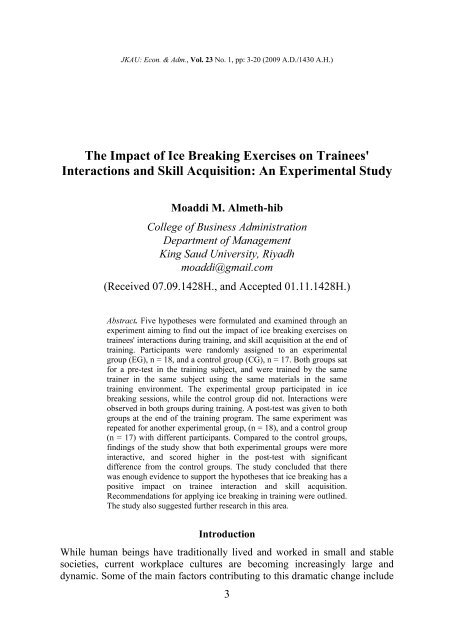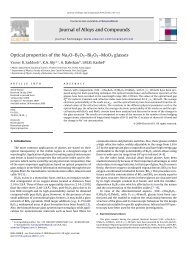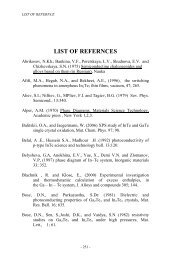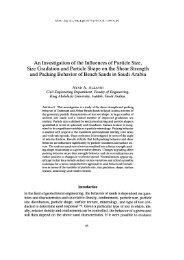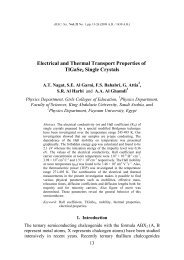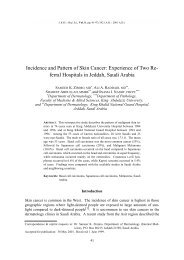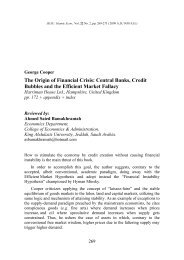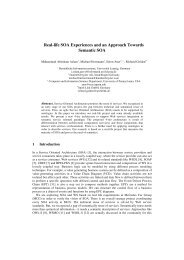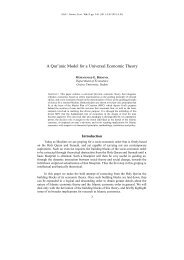The Impact of Ice Breaking Exercises on Trainees' Interactions and ...
The Impact of Ice Breaking Exercises on Trainees' Interactions and ...
The Impact of Ice Breaking Exercises on Trainees' Interactions and ...
Create successful ePaper yourself
Turn your PDF publications into a flip-book with our unique Google optimized e-Paper software.
JKAU: Ec<strong>on</strong>. & Adm., Vol. 23 No. 1, pp: 3-20 (2009 A.D./1430 A.H.)<br />
<str<strong>on</strong>g>The</str<strong>on</strong>g> <str<strong>on</strong>g>Impact</str<strong>on</strong>g> <str<strong>on</strong>g>of</str<strong>on</strong>g> <str<strong>on</strong>g>Ice</str<strong>on</strong>g> <str<strong>on</strong>g>Breaking</str<strong>on</strong>g> <str<strong>on</strong>g>Exercises</str<strong>on</strong>g> <strong>on</strong> <strong>Trainees'</strong><br />
Interacti<strong>on</strong>s <strong>and</strong> Skill Acquisiti<strong>on</strong>: An Experimental Study<br />
Moaddi M. Almeth-hib<br />
College <str<strong>on</strong>g>of</str<strong>on</strong>g> Business Administrati<strong>on</strong><br />
Department <str<strong>on</strong>g>of</str<strong>on</strong>g> Management<br />
King Saud University, Riyadh<br />
moaddi@gmail.com<br />
(Received 07.09.1428H., <strong>and</strong> Accepted 01.11.1428H.)<br />
Abstract. Five hypotheses were formulated <strong>and</strong> examined through an<br />
experiment aiming to find out the impact <str<strong>on</strong>g>of</str<strong>on</strong>g> ice breaking exercises <strong>on</strong><br />
trainees' interacti<strong>on</strong>s during training, <strong>and</strong> skill acquisiti<strong>on</strong> at the end <str<strong>on</strong>g>of</str<strong>on</strong>g><br />
training. Participants were r<strong>and</strong>omly assigned to an experimental<br />
group (EG), n = 18, <strong>and</strong> a c<strong>on</strong>trol group (CG), n = 17. Both groups sat<br />
for a pre-test in the training subject, <strong>and</strong> were trained by the same<br />
trainer in the same subject using the same materials in the same<br />
training envir<strong>on</strong>ment. <str<strong>on</strong>g>The</str<strong>on</strong>g> experimental group participated in ice<br />
breaking sessi<strong>on</strong>s, while the c<strong>on</strong>trol group did not. Interacti<strong>on</strong>s were<br />
observed in both groups during training. A post-test was given to both<br />
groups at the end <str<strong>on</strong>g>of</str<strong>on</strong>g> the training program. <str<strong>on</strong>g>The</str<strong>on</strong>g> same experiment was<br />
repeated for another experimental group, (n = 18), <strong>and</strong> a c<strong>on</strong>trol group<br />
(n = 17) with different participants. Compared to the c<strong>on</strong>trol groups,<br />
findings <str<strong>on</strong>g>of</str<strong>on</strong>g> the study show that both experimental groups were more<br />
interactive, <strong>and</strong> scored higher in the post-test with significant<br />
difference from the c<strong>on</strong>trol groups. <str<strong>on</strong>g>The</str<strong>on</strong>g> study c<strong>on</strong>cluded that there<br />
was enough evidence to support the hypotheses that ice breaking has a<br />
positive impact <strong>on</strong> trainee interacti<strong>on</strong> <strong>and</strong> skill acquisiti<strong>on</strong>.<br />
Recommendati<strong>on</strong>s for applying ice breaking in training were outlined.<br />
<str<strong>on</strong>g>The</str<strong>on</strong>g> study also suggested further research in this area.<br />
Introducti<strong>on</strong><br />
While human beings have traditi<strong>on</strong>ally lived <strong>and</strong> worked in small <strong>and</strong> stable<br />
societies, current workplace cultures are becoming increasingly large <strong>and</strong><br />
dynamic. Some <str<strong>on</strong>g>of</str<strong>on</strong>g> the main factors c<strong>on</strong>tributing to this dramatic change include<br />
3
4<br />
Moaddi M. Almeth-hib<br />
globalizati<strong>on</strong>, the revoluti<strong>on</strong> in communicati<strong>on</strong>s, <strong>and</strong> an ever-increasing<br />
specializati<strong>on</strong> <str<strong>on</strong>g>of</str<strong>on</strong>g> labor. <str<strong>on</strong>g>The</str<strong>on</strong>g> overall effect <str<strong>on</strong>g>of</str<strong>on</strong>g> these changes is that individuals are<br />
now required to deal with many different groups <str<strong>on</strong>g>of</str<strong>on</strong>g> people in their workplace,<br />
as well as in their pers<strong>on</strong>al lives.<br />
Joining a new group, like in training settings, <strong>and</strong> immediately being<br />
expected to get al<strong>on</strong>g with them is somewhat unnatural <strong>and</strong> may engender a<br />
range <str<strong>on</strong>g>of</str<strong>on</strong>g> c<strong>on</strong>flicting expectati<strong>on</strong>s <str<strong>on</strong>g>of</str<strong>on</strong>g> what the pers<strong>on</strong> will do, learn, <strong>and</strong> whom<br />
he will meet. <str<strong>on</strong>g>The</str<strong>on</strong>g>refore, there is a need for methods to help people, regardless<br />
<str<strong>on</strong>g>of</str<strong>on</strong>g> their pr<str<strong>on</strong>g>of</str<strong>on</strong>g>essi<strong>on</strong>s or past experiences, to adapt <strong>and</strong> emerge into the new<br />
settings (Saks, 1996). A comm<strong>on</strong> ice breaking tactic involves short activities<br />
designed to break down barriers <strong>and</strong> get every<strong>on</strong>e working together before<br />
training. This study will explore the impact <str<strong>on</strong>g>of</str<strong>on</strong>g> such a tactic <strong>on</strong> trainees'<br />
performance during training sessi<strong>on</strong>s <strong>and</strong> <strong>on</strong> the skills gained at the end <str<strong>on</strong>g>of</str<strong>on</strong>g> the<br />
training program.<br />
Research Problem<br />
Research indicates that adult training needs special attenti<strong>on</strong>, particularly at<br />
the beginning <str<strong>on</strong>g>of</str<strong>on</strong>g> training programs (J<strong>on</strong>es, 1986; Allen <strong>and</strong> Meyer, 1990;<br />
Ashforth <strong>and</strong> Saks, 1996; Ashforth et al., 1997). Adults learn more when they<br />
are part <str<strong>on</strong>g>of</str<strong>on</strong>g> the program <strong>and</strong> participate with their colleagues from the beginning<br />
<str<strong>on</strong>g>of</str<strong>on</strong>g> the training process. Newcomers who get in touch with a new group for the<br />
first time usually have initial expectati<strong>on</strong>s which will be tested against reality. A<br />
tentative adjustment in attitude <strong>and</strong> behavior will take place. Participatory ice<br />
breaking activities <strong>and</strong> exercises are necessary tools for teambuilding in training<br />
programs. With the current emphasis <strong>on</strong> a "bottom up approach" to human<br />
development as opposed to "top down approach", wider participati<strong>on</strong> <str<strong>on</strong>g>of</str<strong>on</strong>g> trainees<br />
<strong>and</strong> more interactive training has become more important than before (Saks,<br />
1996).<br />
Some training prop<strong>on</strong>ents suggest that any training workshop <str<strong>on</strong>g>of</str<strong>on</strong>g> <strong>on</strong>e full<br />
day or more should have an "ice breaking" sessi<strong>on</strong> <str<strong>on</strong>g>of</str<strong>on</strong>g> approximately 50<br />
minutes, scheduled at the beginning <str<strong>on</strong>g>of</str<strong>on</strong>g> the workshop, (Pike, 2004;.scn.org).<br />
This is based <strong>on</strong> the assumpti<strong>on</strong> that training is improved by prior ice breaking<br />
sessi<strong>on</strong>s. Taking this into c<strong>on</strong>siderati<strong>on</strong> in determining effective training<br />
method, the present study focuses <strong>on</strong> the difference that ice breaking makes in<br />
trainees’ interacti<strong>on</strong> during training as well as the skills gained.<br />
Research Hypotheses<br />
Experimental groups were exposed to ice breaking sessi<strong>on</strong>s; c<strong>on</strong>trol groups<br />
were not. <str<strong>on</strong>g>The</str<strong>on</strong>g> study postulates five hypotheses to be tested:
<str<strong>on</strong>g>The</str<strong>on</strong>g> <str<strong>on</strong>g>Impact</str<strong>on</strong>g> <str<strong>on</strong>g>of</str<strong>on</strong>g> <str<strong>on</strong>g>Ice</str<strong>on</strong>g> <str<strong>on</strong>g>Breaking</str<strong>on</strong>g> <str<strong>on</strong>g>Exercises</str<strong>on</strong>g> <strong>on</strong> <strong>Trainees'</strong> Interacti<strong>on</strong>s <strong>and</strong> Skill Acquisiti<strong>on</strong> …<br />
H1: <strong>Trainees'</strong> interacti<strong>on</strong>s in experimental groups will be better than that<br />
<str<strong>on</strong>g>of</str<strong>on</strong>g> c<strong>on</strong>trol groups.<br />
H2: No statistical differences in mean pre-test scores will be observed<br />
between experimental groups <strong>and</strong> c<strong>on</strong>trol groups.<br />
H3: Statistical differences in mean post-test scores will be observed<br />
between experimental groups <strong>and</strong> c<strong>on</strong>trol groups.<br />
H4: Statistical differences in mean pre- <strong>and</strong> post-test scores will be<br />
observed am<strong>on</strong>g experimental groups.<br />
H5: Statistical differences in mean pre <strong>and</strong> post test scores will be<br />
observed am<strong>on</strong>g c<strong>on</strong>trol groups.<br />
Importance <str<strong>on</strong>g>of</str<strong>on</strong>g> the Study<br />
Most <str<strong>on</strong>g>of</str<strong>on</strong>g> what has been written in training literature focuses mainly <strong>on</strong> the<br />
training cycle, starting from needs assessment <strong>and</strong> ending up with training<br />
evaluati<strong>on</strong>. One <str<strong>on</strong>g>of</str<strong>on</strong>g> the most neglected dimensi<strong>on</strong>s in the training cycle,<br />
nevertheless, is human interacti<strong>on</strong> during training. Feedback gathered from<br />
participants at the end <str<strong>on</strong>g>of</str<strong>on</strong>g> a training program have raised validity <strong>and</strong> reliability<br />
questi<strong>on</strong>s as the trainers <strong>and</strong> trainees all breathe a sigh <str<strong>on</strong>g>of</str<strong>on</strong>g> relief (Mann <strong>and</strong><br />
Roberts<strong>on</strong>1, 996; James <strong>and</strong> R<str<strong>on</strong>g>of</str<strong>on</strong>g>fe, 2000, Hunt <strong>and</strong> Baruch, 2003).<br />
Organizati<strong>on</strong>s spend a significant porti<strong>on</strong> <str<strong>on</strong>g>of</str<strong>on</strong>g> their human resources allocati<strong>on</strong>s<br />
<strong>on</strong> training their staff in order to increase their productivity. Such financial<br />
resources must be spent <strong>on</strong> something that is worthy <strong>and</strong> beneficial (Read <strong>and</strong><br />
Kleiner, 1996; Tennant et al., 2002).<br />
One way <str<strong>on</strong>g>of</str<strong>on</strong>g> determining whether resources are fully utilized is to c<strong>on</strong>duct a<br />
scientific research <strong>on</strong> the way training programs are being executed to find if<br />
they make a difference in group dynamics <strong>and</strong> skills acquisiti<strong>on</strong> during training.<br />
Mann <strong>and</strong> Roberts<strong>on</strong> (1996) suggest pre- <strong>and</strong> post-test assessments <str<strong>on</strong>g>of</str<strong>on</strong>g> skills<br />
acquisiti<strong>on</strong> as a means <str<strong>on</strong>g>of</str<strong>on</strong>g> evaluating this. Our study sheds light <strong>on</strong> "ice<br />
breaking" tactics that seem to be <str<strong>on</strong>g>of</str<strong>on</strong>g> relevance to trainers, trainees, <strong>and</strong><br />
organizati<strong>on</strong>s. Researchers have asserted the importance <str<strong>on</strong>g>of</str<strong>on</strong>g> doing more research<br />
<strong>on</strong> this area <str<strong>on</strong>g>of</str<strong>on</strong>g> training (Anders<strong>on</strong> <strong>and</strong> Thomas, 1996; Chen <strong>and</strong> Klimoski,<br />
2003).<br />
A notable gap in ice breaking <strong>and</strong> organizati<strong>on</strong>al socializati<strong>on</strong> research is<br />
the small number <str<strong>on</strong>g>of</str<strong>on</strong>g> studies that investigate its impact <strong>on</strong> performance,<br />
integrati<strong>on</strong> <str<strong>on</strong>g>of</str<strong>on</strong>g> newcomers with their colleagues, teams work, <strong>and</strong> the setting<br />
they work in (Bauer et al., 1998). No single study about the nature <str<strong>on</strong>g>of</str<strong>on</strong>g> the<br />
current study is found in the literature. It is hoped that the current study will<br />
5
6<br />
Moaddi M. Almeth-hib<br />
increase our underst<strong>and</strong>ing <str<strong>on</strong>g>of</str<strong>on</strong>g> applying a new technique in training, <strong>and</strong> finding<br />
out the difference it makes, especially in the Arabic culture.<br />
Literature Review<br />
Traditi<strong>on</strong>al training literature has led to a belief that trainees learn best by<br />
listening to trainers. It has been found, however, that training which results in<br />
increased self-awareness, changed behavior, <strong>and</strong> the acquisiti<strong>on</strong> <str<strong>on</strong>g>of</str<strong>on</strong>g> new skills<br />
must actively engage the individual in the training process through fun <strong>and</strong><br />
openness to others <strong>and</strong> help to empower trainees (Men<strong>on</strong>, 1995). In particular,<br />
training is an innately human activity <strong>and</strong> adults have been found to learn more<br />
effectively by sharing, experiencing, <strong>and</strong> interacting with their peers or what is<br />
sometimes called interactive empowerment (Vogt <strong>and</strong> Murrell, 1990). Such<br />
interacti<strong>on</strong>s am<strong>on</strong>g trainees are usually difficult to achieve with no interventi<strong>on</strong><br />
by the trainer (Saks, 1996). Although <strong>on</strong>e <str<strong>on</strong>g>of</str<strong>on</strong>g> the main challenges for a trainer is to<br />
help group members to be more open with each other <strong>and</strong> be more dynamic, the<br />
trainer can facilitate <strong>and</strong> make the training smother by doing some ice breaking<br />
exercises <strong>and</strong> activities at the beginning <str<strong>on</strong>g>of</str<strong>on</strong>g> training program (Pike, 1994).<br />
According to the American Heritage Dicti<strong>on</strong>ary <str<strong>on</strong>g>of</str<strong>on</strong>g> the English Language,<br />
ice breaking is something d<strong>on</strong>e or said to relax an unduly formal atmosphere or<br />
situati<strong>on</strong> at the start. More precisely, the purposes <strong>and</strong> benefits <str<strong>on</strong>g>of</str<strong>on</strong>g> ice-breaking<br />
activities are: (1) to encourage all participants in breaking down <strong>and</strong> discarding<br />
rigid formality, status, prestige, authority, structured attitudes <strong>and</strong> behavior<br />
habitually employed in day-to-day activities; (2) to encourage all participants to<br />
relax <strong>and</strong> enjoy themselves <strong>and</strong> each other as pers<strong>on</strong>s, not limited to roles or<br />
status holders, in preparati<strong>on</strong> to becoming more open <strong>and</strong> open-minded towards<br />
the substantive training to follow; (3) to encourage participants to interact with<br />
each other <strong>and</strong> get to know each other in n<strong>on</strong>-orthodox <strong>and</strong> untraditi<strong>on</strong>al<br />
c<strong>on</strong>texts; (4) to s<str<strong>on</strong>g>of</str<strong>on</strong>g>ten up participants before they face the core material <str<strong>on</strong>g>of</str<strong>on</strong>g> the<br />
training; <strong>and</strong>, (5) to improve the training process <str<strong>on</strong>g>of</str<strong>on</strong>g> the overall training<br />
workshop by preparing the participants as above (Feij, 1998; Joost et al., 2001;<br />
Wanous, 1992; Wanous et al., 1984; scn.org).<br />
<str<strong>on</strong>g>The</str<strong>on</strong>g> above menti<strong>on</strong>ed benefits <str<strong>on</strong>g>of</str<strong>on</strong>g> ice breaking can be also linked to<br />
Skinner's theory <str<strong>on</strong>g>of</str<strong>on</strong>g> stimulus <strong>and</strong> resp<strong>on</strong>se in which he c<strong>on</strong>cluded that each<br />
stimulus has a resp<strong>on</strong>se (Fadlallh, 1998). <str<strong>on</strong>g>The</str<strong>on</strong>g> stimulus here is ice breaking<br />
while the resp<strong>on</strong>se is the interacti<strong>on</strong>s am<strong>on</strong>g trainees which lead to a better<br />
underst<strong>and</strong>ing am<strong>on</strong>g participants reflected, c<strong>on</strong>sequently, <strong>on</strong> the training social<br />
envir<strong>on</strong>ment <strong>and</strong> acquisiti<strong>on</strong> <str<strong>on</strong>g>of</str<strong>on</strong>g> skills. Henry Dens<strong>on</strong> also stresses <strong>on</strong> the noti<strong>on</strong><br />
<str<strong>on</strong>g>of</str<strong>on</strong>g> the starting point <str<strong>on</strong>g>of</str<strong>on</strong>g> an individual when joining a new group. He implicitly<br />
menti<strong>on</strong>ed the importance <str<strong>on</strong>g>of</str<strong>on</strong>g> breaking the ice by the pers<strong>on</strong> in charge, the<br />
trainer in this c<strong>on</strong>text, in order to have an effective team work (Alm<strong>on</strong>ef, 1995).<br />
In comparis<strong>on</strong> to the individual approach, Vries (2004) argues that a group
<str<strong>on</strong>g>The</str<strong>on</strong>g> <str<strong>on</strong>g>Impact</str<strong>on</strong>g> <str<strong>on</strong>g>of</str<strong>on</strong>g> <str<strong>on</strong>g>Ice</str<strong>on</strong>g> <str<strong>on</strong>g>Breaking</str<strong>on</strong>g> <str<strong>on</strong>g>Exercises</str<strong>on</strong>g> <strong>on</strong> <strong>Trainees'</strong> Interacti<strong>on</strong>s <strong>and</strong> Skill Acquisiti<strong>on</strong> …<br />
approach provides peer support. Human Relati<strong>on</strong>s School <str<strong>on</strong>g>of</str<strong>on</strong>g> Management<br />
resembled in Hawthr<strong>on</strong>e experiments indicates that people in a working group<br />
need to feel welcomed, <strong>and</strong> to c<strong>on</strong>stantly interact with each other.<br />
<str<strong>on</strong>g>The</str<strong>on</strong>g> Japanese are well-known for applying the noti<strong>on</strong> <str<strong>on</strong>g>of</str<strong>on</strong>g> ice breaking in<br />
their daily work culture. For example, employees say aloud together the motto<br />
<str<strong>on</strong>g>of</str<strong>on</strong>g> the company they work in, <strong>and</strong> then do some stretching <str<strong>on</strong>g>of</str<strong>on</strong>g> the same length<br />
daily. Furthermore, group work in Japan is <str<strong>on</strong>g>of</str<strong>on</strong>g>ten regarded as more powerful <strong>and</strong><br />
productive than working individually (Saamani, 2005). <str<strong>on</strong>g>The</str<strong>on</strong>g> key to Japanese<br />
effectiveness is the combined brainpower <str<strong>on</strong>g>of</str<strong>on</strong>g> all its employees <strong>and</strong> the fostering<br />
<str<strong>on</strong>g>of</str<strong>on</strong>g> intense exchange <strong>and</strong> communicati<strong>on</strong> (Glass, 1991). While some believe that<br />
social values are the most important factor which makes nati<strong>on</strong>alities differ in<br />
their group work dynamics, attitudes, <strong>and</strong> interacti<strong>on</strong>s, studies show that<br />
training <strong>and</strong> organizati<strong>on</strong>al cultures are the key factors that make the unique<br />
nati<strong>on</strong>al differences in this regard (Misumi, 1993).<br />
<str<strong>on</strong>g>Ice</str<strong>on</strong>g> breaking in training can also be traced theoretically to Organizati<strong>on</strong>al<br />
Socializati<strong>on</strong> (OS), sometimes called employee orientati<strong>on</strong> or preparati<strong>on</strong>. OS is<br />
the process through which a newcomer joins a group <str<strong>on</strong>g>of</str<strong>on</strong>g> work, <strong>and</strong> gets<br />
integrated <strong>and</strong> becomes an effective participant in the group, usually through a<br />
third party, which is the trainer in our case. OS applies more to new employees<br />
<strong>and</strong> to transferred employees whether between organizati<strong>on</strong>s or within<br />
organizati<strong>on</strong>s (Van Maanen <strong>and</strong> Schein, 1979). However, OS can include<br />
changes in or the development <str<strong>on</strong>g>of</str<strong>on</strong>g> new skills, knowledge, abilities, attitudes,<br />
values, <strong>and</strong> relati<strong>on</strong>ships, <strong>and</strong> the development <str<strong>on</strong>g>of</str<strong>on</strong>g> appropriate sense-making<br />
frameworks such as ice breaking in training settings (Chatman, 1991; Chao et<br />
al., 1994; Thomas <strong>and</strong> Anders<strong>on</strong>, 1998; Wanberg <strong>and</strong> Kammeyer-Mueller,<br />
2000; De Vos et al., 2003).<br />
Some models that indirectly address OS are relevant to a broad range <str<strong>on</strong>g>of</str<strong>on</strong>g><br />
groups <strong>and</strong> indirectly relate to ice breaking. Ostr<str<strong>on</strong>g>of</str<strong>on</strong>g>f <strong>and</strong> Kozlowski (1992), for<br />
example, emphasized group process as a core step in socializati<strong>on</strong>. While<br />
Taormina (2004) asserts that training, support <str<strong>on</strong>g>of</str<strong>on</strong>g> colleagues, <strong>and</strong> underst<strong>and</strong>ing<br />
are essential dimensi<strong>on</strong>s in participants' socializati<strong>on</strong> <strong>and</strong> interacti<strong>on</strong>s, Haueter<br />
et al., (2003) focused <strong>on</strong> group formulati<strong>on</strong>, task, <strong>and</strong> organizati<strong>on</strong>. Similarly,<br />
Cooper <strong>and</strong> Anders<strong>on</strong> (2002) covered role, social, <strong>and</strong> interpers<strong>on</strong>al<br />
communicati<strong>on</strong>.<br />
In team building training, success comes by having a team mobilized to<br />
perform. Each individual must be integrated fully into the team. Comm<strong>on</strong><br />
values, aspirati<strong>on</strong>s, commitment to <strong>on</strong>e another’s success, <strong>and</strong> cooperati<strong>on</strong> are<br />
paramount in forming a cohesive team (Martin, <strong>and</strong> Davids, 1995). Participants'<br />
mobilizati<strong>on</strong>, therefore, is a key factor which can <strong>on</strong>ly be performed efficiently<br />
by the active involvement <str<strong>on</strong>g>of</str<strong>on</strong>g> trainers <strong>and</strong> team members. This, in turn, implies<br />
7
8<br />
Moaddi M. Almeth-hib<br />
proper training <strong>and</strong> development <str<strong>on</strong>g>of</str<strong>on</strong>g> individuals with the whole group being<br />
committed to help each individual to succeed (Mestre et al., 1997).<br />
Traditi<strong>on</strong>ally, training is focused <strong>on</strong> presentati<strong>on</strong>, lectures <strong>and</strong> a classroomlike<br />
envir<strong>on</strong>ment. That is, trainees expect the trainer to begin lecturing from the<br />
first minute <strong>and</strong> deliver a lecture in a teacher-led way while the role <str<strong>on</strong>g>of</str<strong>on</strong>g> the<br />
trainee is to absorb the informati<strong>on</strong>. This approach has changed over the last<br />
two decades even in educati<strong>on</strong>, where it first started, especially with the<br />
advancement <str<strong>on</strong>g>of</str<strong>on</strong>g> technology (Neo <strong>and</strong> Mai, 2004). <str<strong>on</strong>g>The</str<strong>on</strong>g> new trend in training is<br />
that the trainer plays the role <str<strong>on</strong>g>of</str<strong>on</strong>g> the facilitator especially at the inaugurati<strong>on</strong> <str<strong>on</strong>g>of</str<strong>on</strong>g><br />
training <strong>and</strong> is similar to a socializati<strong>on</strong> agent who releases tensi<strong>on</strong>s, breaks<br />
barriers, <strong>and</strong> forms the values <strong>and</strong> expected behavior for the group.<br />
Training methods literature has focused <strong>on</strong> the means <str<strong>on</strong>g>of</str<strong>on</strong>g> delivering training<br />
courses. <str<strong>on</strong>g>The</str<strong>on</strong>g> top ten training methods are: videotapes, lectures, <strong>on</strong>e-<strong>on</strong>-<strong>on</strong>e<br />
instructi<strong>on</strong>, role playing activities, games/simulati<strong>on</strong>, case studies, slides,<br />
computer-based training, audio tapes <strong>and</strong> films (Read <strong>and</strong> Kleiner, 1996). Read<br />
<strong>and</strong> Kleiner discussed the factors to c<strong>on</strong>sider when selecting a training method<br />
or combinati<strong>on</strong> <str<strong>on</strong>g>of</str<strong>on</strong>g> methods, <strong>and</strong> emphasized the importance <str<strong>on</strong>g>of</str<strong>on</strong>g> post-training<br />
evaluati<strong>on</strong>. Regardless <str<strong>on</strong>g>of</str<strong>on</strong>g> what method is used, trainees tend to appreciate <strong>and</strong><br />
c<strong>on</strong>tinue learning in settings where they feel they have a significant c<strong>on</strong>tributi<strong>on</strong><br />
to make to the discussi<strong>on</strong>, <strong>and</strong> that their c<strong>on</strong>tributi<strong>on</strong>s are acknowledged <strong>and</strong><br />
appreciated by the group as a whole.<br />
Furthermore, trainees tend to rely <strong>on</strong> colleagues who may also be experts<br />
in their pr<str<strong>on</strong>g>of</str<strong>on</strong>g>essi<strong>on</strong>al field for guidance when embarking <strong>on</strong> a new training<br />
venture. Such benefits might not happen if group members were not prepared<br />
(Ardts et al., 2001). Some <str<strong>on</strong>g>of</str<strong>on</strong>g> the main indicators observed in an interactive<br />
group are: questi<strong>on</strong>s/ answers, punctuality, absenteeism, collegiality, cooperati<strong>on</strong>;<br />
support, sympathy, humor, proposing, vivacity <strong>and</strong> openness,<br />
defending <strong>and</strong> attacking (Midgley <strong>and</strong> Rougetel, 1994; Feij; 1998).<br />
No previous studies <str<strong>on</strong>g>of</str<strong>on</strong>g> this type were found in the literature. Some indirect<br />
studies; however, have indicated that framing at the start <str<strong>on</strong>g>of</str<strong>on</strong>g> training impacts<br />
trainees' attitudes, interacti<strong>on</strong> <strong>and</strong> motivati<strong>on</strong>, since they gain self-efficacy from<br />
the start <str<strong>on</strong>g>of</str<strong>on</strong>g> the training program (Tai, 2006). Other studies in the educati<strong>on</strong> field<br />
reached the same c<strong>on</strong>clusi<strong>on</strong> (Hodgkins<strong>on</strong>, 2002). Kleinman et al (2002)<br />
studied the ability <str<strong>on</strong>g>of</str<strong>on</strong>g> team social interacti<strong>on</strong> processes within work teams. <str<strong>on</strong>g>The</str<strong>on</strong>g><br />
study indicated that social interacti<strong>on</strong> process was significantly related to an<br />
employee's orientati<strong>on</strong> toward team work, <strong>and</strong> recommended that teams be<br />
provided with an envir<strong>on</strong>ment wherein individuals experience a positive social<br />
interacti<strong>on</strong> process.<br />
Other studies also found that trainees learn more when an interacti<strong>on</strong><br />
approach is implemented (Midgley <strong>and</strong> Rougetel, 1994; D<strong>on</strong>avan et al., 2004).
<str<strong>on</strong>g>The</str<strong>on</strong>g> <str<strong>on</strong>g>Impact</str<strong>on</strong>g> <str<strong>on</strong>g>of</str<strong>on</strong>g> <str<strong>on</strong>g>Ice</str<strong>on</strong>g> <str<strong>on</strong>g>Breaking</str<strong>on</strong>g> <str<strong>on</strong>g>Exercises</str<strong>on</strong>g> <strong>on</strong> <strong>Trainees'</strong> Interacti<strong>on</strong>s <strong>and</strong> Skill Acquisiti<strong>on</strong> …<br />
Another study describes the relative effectiveness <str<strong>on</strong>g>of</str<strong>on</strong>g> alternative training<br />
methods to attain specific types <str<strong>on</strong>g>of</str<strong>on</strong>g> training objectives <strong>and</strong> c<strong>on</strong>cluded that <strong>on</strong>eto-<strong>on</strong>e<br />
training is the preferred method for knowledge acquisiti<strong>on</strong>. On the other<br />
h<strong>and</strong>, participants perceive this method to be less useful in changing attitudes<br />
<strong>and</strong> in gaining trainees' acceptance (Perdue et al., 2002).<br />
Research Design <strong>and</strong> Methods<br />
<str<strong>on</strong>g>The</str<strong>on</strong>g> study applied an experimental research technique to an experimental<br />
<strong>and</strong> a c<strong>on</strong>trol group, for two rounds. <str<strong>on</strong>g>The</str<strong>on</strong>g> following explains the design <str<strong>on</strong>g>of</str<strong>on</strong>g> the<br />
study:<br />
First Round<br />
Sec<strong>on</strong>d Round<br />
where is:<br />
Eg1 Pre-T X Post-T<br />
Cg1 Pre-T O Post-T<br />
Eg2 Pre-T X Post-T<br />
Cg2 Pre-T 0 Post-T<br />
EG1: Experimental Group #1 Pre-T: Pre-Test<br />
CG1: C<strong>on</strong>trol Group # 1 Post-T: Post-T<br />
EG2: Experimental Group # 2 X: <str<strong>on</strong>g>The</str<strong>on</strong>g> Experiment (exposure to ice breaking)<br />
CG2: C<strong>on</strong>trol Group # 2 0: No experiment<br />
� ������������������:<br />
R<strong>and</strong>om assignment<br />
Participants were screened before registering in the training program to<br />
make sure that they are similar in age, length <str<strong>on</strong>g>of</str<strong>on</strong>g> experience, educati<strong>on</strong>, gender,<br />
<strong>and</strong> had not previously attended a similar training course. <str<strong>on</strong>g>The</str<strong>on</strong>g>y were r<strong>and</strong>omly<br />
assigned to four groups, the experimental groups were also r<strong>and</strong>omly chosen<br />
from the four groups. Participants did not know each other before training. <str<strong>on</strong>g>The</str<strong>on</strong>g>y<br />
came from different cities in Saudi Arabia <strong>and</strong> they worked for various<br />
organizati<strong>on</strong>s, public, private, <strong>and</strong> n<strong>on</strong>-pr<str<strong>on</strong>g>of</str<strong>on</strong>g>it. <str<strong>on</strong>g>The</str<strong>on</strong>g> training took a place in a<br />
private training center in Riyadh.<br />
Before the training started, both experimental <strong>and</strong> c<strong>on</strong>trol groups were<br />
given a pre-test exam that reflected the skills intended to be gained by<br />
participants at the end <str<strong>on</strong>g>of</str<strong>on</strong>g> training. <str<strong>on</strong>g>The</str<strong>on</strong>g> pre-test was proved for its validity<br />
through a review by research design pr<str<strong>on</strong>g>of</str<strong>on</strong>g>essors <strong>and</strong> experts in the subject <str<strong>on</strong>g>of</str<strong>on</strong>g><br />
training. Reliability <str<strong>on</strong>g>of</str<strong>on</strong>g> the test was very high, Cr<strong>on</strong>bach's alpha = 0.91. <str<strong>on</strong>g>The</str<strong>on</strong>g><br />
experimental group was exposed to ice breaking exercises <strong>and</strong> activities in the<br />
inaugurati<strong>on</strong> <str<strong>on</strong>g>of</str<strong>on</strong>g> the training program, <strong>and</strong> at the first 30 minutes for the<br />
following training days. <str<strong>on</strong>g>The</str<strong>on</strong>g> training lasted for five c<strong>on</strong>tinuous days from 8:00<br />
9
10<br />
Moaddi M. Almeth-hib<br />
AM to 4:00 PM, with few a breaks between sessi<strong>on</strong>s, <strong>and</strong> an hour for lunch<br />
brake <strong>and</strong> no<strong>on</strong> prayer.<br />
<str<strong>on</strong>g>The</str<strong>on</strong>g> c<strong>on</strong>trol group was not exposed to ice breaking exercises <strong>and</strong> activities,<br />
<strong>and</strong> was trained in the same way <strong>and</strong> the same training envir<strong>on</strong>ment as the<br />
experimental group, in the same subject, the same materials. Both groups were<br />
given the same post test at the c<strong>on</strong>clusi<strong>on</strong> <str<strong>on</strong>g>of</str<strong>on</strong>g> training. Observati<strong>on</strong> against some<br />
indicators was used to measure the interacti<strong>on</strong>s <str<strong>on</strong>g>of</str<strong>on</strong>g> trainees during training<br />
sessi<strong>on</strong>s. <str<strong>on</strong>g>The</str<strong>on</strong>g> indicators were examined for validity <strong>and</strong> modified, according to<br />
the feedback <str<strong>on</strong>g>of</str<strong>on</strong>g> referees before the experiment. <str<strong>on</strong>g>The</str<strong>on</strong>g> same experiment was<br />
repeated for other experimental <strong>and</strong> c<strong>on</strong>trol groups with new participants <strong>and</strong><br />
under the same c<strong>on</strong>diti<strong>on</strong>s. <str<strong>on</strong>g>The</str<strong>on</strong>g> training for the sec<strong>on</strong>d round was during the<br />
c<strong>on</strong>secutive week <str<strong>on</strong>g>of</str<strong>on</strong>g> the first round. <str<strong>on</strong>g>The</str<strong>on</strong>g> subject <str<strong>on</strong>g>of</str<strong>on</strong>g> training in the four programs<br />
were building <strong>and</strong> maintaining effective team work.<br />
Applying the Experiment<br />
<str<strong>on</strong>g>The</str<strong>on</strong>g> trainer began the sessi<strong>on</strong> by introducing himself, stating the objectives<br />
<str<strong>on</strong>g>of</str<strong>on</strong>g> the training course, then asked each pair <str<strong>on</strong>g>of</str<strong>on</strong>g> participants to introduce each<br />
other. <str<strong>on</strong>g>The</str<strong>on</strong>g> trainer informed the group that in order to relax <strong>and</strong> release tensi<strong>on</strong>s,<br />
everybody in the group will participate in ice breaking activities. Trainees who<br />
were hesitant to participate were encouraged by the trainer, his assistant, <strong>and</strong><br />
other trainees. To overcome formality, <strong>and</strong> for the purpose <str<strong>on</strong>g>of</str<strong>on</strong>g> easy movements,<br />
all participants were asked to take <str<strong>on</strong>g>of</str<strong>on</strong>g>f their traditi<strong>on</strong>al head scarves, empty their<br />
pockets, <strong>and</strong> put their pers<strong>on</strong>al stuff in a safe place.<br />
<str<strong>on</strong>g>The</str<strong>on</strong>g>y were then asked to line up in alphabetical order, <strong>and</strong> then form a<br />
circle around the room st<strong>and</strong>ing in the correct order <str<strong>on</strong>g>of</str<strong>on</strong>g> their date <str<strong>on</strong>g>of</str<strong>on</strong>g> birth. <str<strong>on</strong>g>The</str<strong>on</strong>g>y<br />
were asked not to talk whilst they organized themselves in a circle, so there<br />
would be plenty <str<strong>on</strong>g>of</str<strong>on</strong>g> sign language <strong>and</strong> interacti<strong>on</strong>s. Once every<strong>on</strong>e is in place, the<br />
trainer walks around the circle asking each participant to state his date <str<strong>on</strong>g>of</str<strong>on</strong>g> birth.<br />
Stretching exercises were introduced to the whole group with the help <str<strong>on</strong>g>of</str<strong>on</strong>g> an<br />
assistant. This lasted for 15 minutes. After that, group members were divided<br />
into three subgroups to perform some creative tasks <strong>and</strong> competitive games.<br />
This lasted for another 30 minutes. <str<strong>on</strong>g>The</str<strong>on</strong>g> trainer then wrote the training group<br />
expectati<strong>on</strong>s, lined out the rules <strong>and</strong> values <str<strong>on</strong>g>of</str<strong>on</strong>g> the training sessi<strong>on</strong>s. Participants,<br />
then, were given a break before starting the first training sessi<strong>on</strong>.<br />
<str<strong>on</strong>g>The</str<strong>on</strong>g>se ice breaking sessi<strong>on</strong>s were repeated <strong>on</strong> the following four training<br />
days, but with less time devoted to them. <str<strong>on</strong>g>The</str<strong>on</strong>g> same stretching exercises<br />
introduced in the first day were repeated, but games were shorter <strong>and</strong> different<br />
each day. <str<strong>on</strong>g>The</str<strong>on</strong>g> same procedures were used in the two rounds <str<strong>on</strong>g>of</str<strong>on</strong>g> the experiments.<br />
No drop outs were observed am<strong>on</strong>g participants after the first day with the<br />
excepti<strong>on</strong> <str<strong>on</strong>g>of</str<strong>on</strong>g> two participants who left in the sec<strong>on</strong>d round, <strong>on</strong>e from each
<str<strong>on</strong>g>The</str<strong>on</strong>g> <str<strong>on</strong>g>Impact</str<strong>on</strong>g> <str<strong>on</strong>g>of</str<strong>on</strong>g> <str<strong>on</strong>g>Ice</str<strong>on</strong>g> <str<strong>on</strong>g>Breaking</str<strong>on</strong>g> <str<strong>on</strong>g>Exercises</str<strong>on</strong>g> <strong>on</strong> <strong>Trainees'</strong> Interacti<strong>on</strong>s <strong>and</strong> Skill Acquisiti<strong>on</strong> …<br />
group: <strong>on</strong>e left the experimental group, when called back by his organizati<strong>on</strong> for<br />
an emergency, the other, from the c<strong>on</strong>trol group, left for unknown reas<strong>on</strong>s. <str<strong>on</strong>g>The</str<strong>on</strong>g>y<br />
were not included in the analysis.<br />
Descripti<strong>on</strong> <str<strong>on</strong>g>of</str<strong>on</strong>g> the Study Samples<br />
All participants in experimental groups were Saudi males. <str<strong>on</strong>g>The</str<strong>on</strong>g>ir mean age<br />
was 31 years <strong>and</strong> all held bachelors degrees. <str<strong>on</strong>g>The</str<strong>on</strong>g>ir mean work experience was<br />
nine years. <str<strong>on</strong>g>The</str<strong>on</strong>g> participants in the other two c<strong>on</strong>trol groups were also Saudi<br />
males, their mean age was 32.5 years. All had bachelors degrees, <strong>and</strong> their mean<br />
work experience was ten <strong>and</strong> a half years. <str<strong>on</strong>g>The</str<strong>on</strong>g>refore, it can be said that the<br />
participants in all groups were similar in their pers<strong>on</strong>al variables.<br />
Results<br />
It was hypothesized, (H1), that trainees' interacti<strong>on</strong> in the experimental<br />
groups exposed to ice breaking sessi<strong>on</strong>s would be better than the interacti<strong>on</strong>s <str<strong>on</strong>g>of</str<strong>on</strong>g><br />
trainees in the c<strong>on</strong>trol groups, which were not exposed to ice breaking sessi<strong>on</strong>s.<br />
Table 1 compares the observati<strong>on</strong>s about the groups taken by the researcher<br />
during training sessi<strong>on</strong>s. This shows that the experimental groups scored high in<br />
most indicators used to measure interacti<strong>on</strong>. In fact, both experimental groups<br />
scored well in openness, vivacity, answering questi<strong>on</strong>s, comments, sympathy,<br />
<strong>and</strong> humor. Raising questi<strong>on</strong>s, punctuality, propositi<strong>on</strong>s, <strong>and</strong> within group<br />
participati<strong>on</strong> were medium in <strong>on</strong>e <str<strong>on</strong>g>of</str<strong>on</strong>g> the experimental groups.<br />
Table 1. A comparis<strong>on</strong> <str<strong>on</strong>g>of</str<strong>on</strong>g> experimental <strong>and</strong> c<strong>on</strong>trol group interacti<strong>on</strong> during training sessi<strong>on</strong>s.<br />
Experimental groups C<strong>on</strong>trol groups<br />
EG1 EG2 CG1 CG2<br />
Interacti<strong>on</strong>s indicators H M L H M L H M L H M L<br />
Openness X X X X<br />
Vivacity X X X X<br />
Raising questi<strong>on</strong>s X X X X<br />
Answering questi<strong>on</strong>s X X X X<br />
Comments X X X X<br />
Sympathy X X X X<br />
Punctuality X X X X<br />
Within-Group participati<strong>on</strong> X X X X<br />
Humor X X X X<br />
Propositi<strong>on</strong> X X X X<br />
Cooperati<strong>on</strong> X X X X<br />
Notes:<br />
EG1: Experimental Group # 1 H: High<br />
EG2: Experimental Group # 2 M: Medium<br />
CG1: C<strong>on</strong>trol Group # 1 L: Low<br />
CG2: C<strong>on</strong>trol Group # 2 X: Indicator observed<br />
11
12<br />
Moaddi M. Almeth-hib<br />
<str<strong>on</strong>g>The</str<strong>on</strong>g> c<strong>on</strong>trol groups, <strong>on</strong> the other h<strong>and</strong>, scored lower in their interacti<strong>on</strong>s<br />
when compared to the experimental groups in all indicators except in<br />
punctuality, in the first round, <strong>and</strong> raising questi<strong>on</strong>s in the sec<strong>on</strong>d round. Both<br />
had average scores in comparis<strong>on</strong> with the experimental groups. Most <str<strong>on</strong>g>of</str<strong>on</strong>g> the<br />
interacti<strong>on</strong>s indicators for both <str<strong>on</strong>g>of</str<strong>on</strong>g> the c<strong>on</strong>trol groups were observed to be low<br />
<strong>and</strong> <strong>on</strong>ly a few indicators were medium. No <strong>on</strong>e indicator scored high in both <str<strong>on</strong>g>of</str<strong>on</strong>g><br />
the c<strong>on</strong>trol groups. <str<strong>on</strong>g>The</str<strong>on</strong>g>refore, it can be said that there is enough evidence to<br />
support (H1): <strong>Trainees'</strong> interacti<strong>on</strong>s in experimental groups will be better than<br />
that <str<strong>on</strong>g>of</str<strong>on</strong>g> c<strong>on</strong>trol groups.<br />
Hypothesis two, (H2), states that there would be no statistical differences<br />
in mean pre-test scores am<strong>on</strong>g experimental groups exposed to ice breaking<br />
sessi<strong>on</strong>s, <strong>and</strong> those <str<strong>on</strong>g>of</str<strong>on</strong>g> the c<strong>on</strong>trol groups, not exposed to ice breaking sessi<strong>on</strong>s.<br />
This hypothesis was formulated in order to make sure that all groups are similar<br />
in their level <str<strong>on</strong>g>of</str<strong>on</strong>g> skill in the training subject. Table 2 c<strong>on</strong>tains the scores <str<strong>on</strong>g>of</str<strong>on</strong>g> pretests<br />
for all groups. It indicates that both the experimental <strong>and</strong> the c<strong>on</strong>trol<br />
groups scored almost identically in the pre-test: their mean scores ranged from<br />
35.1 to 37.8. St<strong>and</strong>ard deviati<strong>on</strong>s were very close in all groups: 3.5; 3.08; 3.3;<br />
<strong>and</strong> 2.8.<br />
Table 2. A comparis<strong>on</strong> <str<strong>on</strong>g>of</str<strong>on</strong>g> mean scores <strong>and</strong> st<strong>and</strong>ard deviati<strong>on</strong>s <str<strong>on</strong>g>of</str<strong>on</strong>g> pre-tests* for both<br />
experimental <strong>and</strong> c<strong>on</strong>trol groups.<br />
Experimental<br />
groups<br />
Notes:<br />
EG1: Experimental Group # 1 EG2: Experimental Group # 2<br />
CG1: C<strong>on</strong>trol Group # 1 CG2: C<strong>on</strong>trol Group # 2<br />
* <str<strong>on</strong>g>The</str<strong>on</strong>g> pre-test was out <str<strong>on</strong>g>of</str<strong>on</strong>g> a 100 score.<br />
C<strong>on</strong>trol<br />
groups<br />
EG1 EG2 CG1 CG2<br />
Mean 37.8 36.8 35.1 37.1<br />
Std. Deviati<strong>on</strong> 3.5 3.08 3.3 2.8<br />
Highest 43.5 41 40 42<br />
Lowest 31 33 29 30<br />
Table 3 includes t-tests <str<strong>on</strong>g>of</str<strong>on</strong>g> both experimental <strong>and</strong> c<strong>on</strong>trol groups. It shows<br />
no significant difference between groups – whether experimental or c<strong>on</strong>trol – in<br />
each round, nor between rounds: two experimental groups together vs. two<br />
c<strong>on</strong>trol groups together. Hence, there is enough evidence to support (H2): that<br />
no statistical differences would be observed in mean scores in the pre-tests<br />
between experimental <strong>and</strong> c<strong>on</strong>trol groups.
<str<strong>on</strong>g>The</str<strong>on</strong>g> <str<strong>on</strong>g>Impact</str<strong>on</strong>g> <str<strong>on</strong>g>of</str<strong>on</strong>g> <str<strong>on</strong>g>Ice</str<strong>on</strong>g> <str<strong>on</strong>g>Breaking</str<strong>on</strong>g> <str<strong>on</strong>g>Exercises</str<strong>on</strong>g> <strong>on</strong> <strong>Trainees'</strong> Interacti<strong>on</strong>s <strong>and</strong> Skill Acquisiti<strong>on</strong> …<br />
Table 3. Differences in pre-test mean scores <str<strong>on</strong>g>of</str<strong>on</strong>g> am<strong>on</strong>g experimental <strong>and</strong> c<strong>on</strong>trol groups.<br />
Groups t value df<br />
Mean<br />
differences<br />
Notes:<br />
EG1: Experimental Group # 1 EG2: Experimental Group # 2<br />
CG1: C<strong>on</strong>trol Group # 1 CG2: C<strong>on</strong>trol Group # 2<br />
EGs: Both <str<strong>on</strong>g>of</str<strong>on</strong>g> the Experimental Groups CGs: Both <str<strong>on</strong>g>of</str<strong>on</strong>g> the C<strong>on</strong>trol Groups<br />
However, the mean scores <str<strong>on</strong>g>of</str<strong>on</strong>g> the experimental groups were higher in the<br />
post-test exam, Table 4. While the mean scores for the experimental groups<br />
were 77.4 <strong>and</strong> 81.1, the mean scores for the other two c<strong>on</strong>trol groups were 55.7<br />
<strong>and</strong> 61.3. St<strong>and</strong>ard deviati<strong>on</strong>s varied moderately in all groups <strong>and</strong> ranged from<br />
1.44 to 3.2 in post-tests.<br />
Table 4. A comparis<strong>on</strong> <str<strong>on</strong>g>of</str<strong>on</strong>g> mean scores <strong>and</strong> st<strong>and</strong>ard deviati<strong>on</strong>s <str<strong>on</strong>g>of</str<strong>on</strong>g> post-tests* for<br />
experimental <strong>and</strong> c<strong>on</strong>trol groups.<br />
Experimental groups C<strong>on</strong>trol groups<br />
EG1 EG2 CG1 CG2<br />
Mean 81.1 77.4 59.7 61.3<br />
Std. Deviati<strong>on</strong> 3.2 2.2 1.44 2.2<br />
Highest 85 80 62 64<br />
Lowest<br />
Notes:<br />
73 71 57 55<br />
EG1: Experimental Group # 1 EG2: Experimental Group # 2<br />
CG1: C<strong>on</strong>trol Group # 1 CG2: C<strong>on</strong>trol Group # 2<br />
* <str<strong>on</strong>g>The</str<strong>on</strong>g> post-test was out <str<strong>on</strong>g>of</str<strong>on</strong>g> a 100 score.<br />
To examine the third hypothesis (H3), t-test results included in Table 5,<br />
show that there were significant differences am<strong>on</strong>g the groups in the post-test<br />
exams. That is, there were significant differences between the mean scores <str<strong>on</strong>g>of</str<strong>on</strong>g>:<br />
Sig.<br />
Std. error<br />
differences<br />
– <str<strong>on</strong>g>The</str<strong>on</strong>g> first experimental <strong>and</strong> c<strong>on</strong>trol groups (t = 25.4, df = 24, p value =<br />
.01);<br />
– <str<strong>on</strong>g>The</str<strong>on</strong>g> sec<strong>on</strong>d experimental <strong>and</strong> c<strong>on</strong>trol groups(t = 21, df = 32, p value<br />
14<br />
Moaddi M. Almeth-hib<br />
Table 5. Differences in post-test mean scores for experimental <strong>and</strong> c<strong>on</strong>trol groups.<br />
Groups<br />
Notes:<br />
t<br />
value<br />
df Mean difference<br />
Std.<br />
error mean<br />
95% C<strong>on</strong>fd. Interval<br />
<str<strong>on</strong>g>of</str<strong>on</strong>g> the difference<br />
Lower Upper<br />
EG1-CG1 25.4 ** 24 21.4 .83 19.6 23.06<br />
EG2-CG2 21 ** 32 16.11 .76 14.5 17.6<br />
EGs-CGs 28.6 ** 56 18.8 .65 17.4 20.1<br />
EG1: Experimental Group number 1 EG2: Experimental Group number 2 ** P < 0.01<br />
CG1: C<strong>on</strong>trol Group number 1 CG2: C<strong>on</strong>trol Group number 2<br />
EGs: Both <str<strong>on</strong>g>of</str<strong>on</strong>g> the Experimental Groups CGs: Both <str<strong>on</strong>g>of</str<strong>on</strong>g> the C<strong>on</strong>trol Groups<br />
It can be said that there are enough evidences that there are differences in<br />
mean scores <str<strong>on</strong>g>of</str<strong>on</strong>g> the post test between trainees in the experimental groups that<br />
were exposed to ice breaking sessi<strong>on</strong>s <strong>and</strong> the trainees in the c<strong>on</strong>trol groups that<br />
were not exposed to ice breaking sessi<strong>on</strong>s.<br />
Table 6 includes t-tests (paired samples) <str<strong>on</strong>g>of</str<strong>on</strong>g> the differences in mean scores<br />
between pre <strong>and</strong> post- tests. <str<strong>on</strong>g>The</str<strong>on</strong>g> table shows that all groups indicate significant<br />
differences in their mean scores (p < .01). This indicates that there is enough<br />
evidence to support the remaining two hypotheses: in the experimental groups,<br />
there would be statistical differences in mean scores between the pre- <strong>and</strong> posttests,<br />
(H4), <strong>and</strong> that there would be statistical differences in mean scores<br />
between pre- <strong>and</strong> post-tests in the c<strong>on</strong>trol groups, (H5).<br />
Table 6. Paired sample differences in pre-post tests for experimental <strong>and</strong> c<strong>on</strong>trol groups.<br />
Groups<br />
EG1<br />
EG2<br />
EGs<br />
CG1<br />
CG2<br />
CGs<br />
Mean<br />
43.2<br />
40.6<br />
41.9<br />
24.7<br />
24.2<br />
24.5<br />
Std. deviati<strong>on</strong><br />
6.5<br />
5.09<br />
5.9<br />
4.7<br />
4.9<br />
4.7<br />
Std. error<br />
mean<br />
1.5<br />
1.2<br />
1<br />
1.1<br />
1.2<br />
.80<br />
95% C<strong>on</strong>fd. interval.<br />
<str<strong>on</strong>g>of</str<strong>on</strong>g> the<br />
difference<br />
Lower Upper<br />
39.9 46.5<br />
38 43.2<br />
39.9 44<br />
22.4 27.1<br />
21.7 26.7<br />
22.8 26.1<br />
t<br />
value<br />
28 **<br />
32.8 **<br />
41.7 **<br />
22.3 **<br />
20.3 **<br />
30.5 **<br />
Notes:<br />
EG1: Experimental Group # 1 EG2: Experimental Group # 2 ** P
<str<strong>on</strong>g>The</str<strong>on</strong>g> <str<strong>on</strong>g>Impact</str<strong>on</strong>g> <str<strong>on</strong>g>of</str<strong>on</strong>g> <str<strong>on</strong>g>Ice</str<strong>on</strong>g> <str<strong>on</strong>g>Breaking</str<strong>on</strong>g> <str<strong>on</strong>g>Exercises</str<strong>on</strong>g> <strong>on</strong> <strong>Trainees'</strong> Interacti<strong>on</strong>s <strong>and</strong> Skill Acquisiti<strong>on</strong> …<br />
One might argue that the difference can be attributed to training, regardless<br />
<str<strong>on</strong>g>of</str<strong>on</strong>g> exposure to ice breaking. Taking into account the c<strong>on</strong>trol over pers<strong>on</strong>al<br />
variables <str<strong>on</strong>g>of</str<strong>on</strong>g> participants in all groups, the r<strong>and</strong>om assignment <str<strong>on</strong>g>of</str<strong>on</strong>g> participants as<br />
well as the groups, the indifference between mean scores <str<strong>on</strong>g>of</str<strong>on</strong>g> all groups in pretests,<br />
<strong>and</strong> the high mean scores <strong>and</strong> c<strong>on</strong>fidence intervals for the experimental<br />
groups included in Table.6, it can be said that ice breaking sessi<strong>on</strong>s have had a<br />
positive impact <strong>on</strong> experimental group acquisiti<strong>on</strong> <str<strong>on</strong>g>of</str<strong>on</strong>g> skills. This finding<br />
supports our third hypothesis: that ice breaking sessi<strong>on</strong>s would produce<br />
differences in mean post-test scores between experimental <strong>and</strong> c<strong>on</strong>trol groups.<br />
Research Implicati<strong>on</strong>s <strong>and</strong> Limitati<strong>on</strong>s<br />
<str<strong>on</strong>g>The</str<strong>on</strong>g> findings <str<strong>on</strong>g>of</str<strong>on</strong>g> this study suggest that those involved in training programs<br />
should devote some time in the orientati<strong>on</strong> phase <str<strong>on</strong>g>of</str<strong>on</strong>g> each training program to ice<br />
breaking activities. Otherwise, training programs may not yield the expected<br />
benefits. <str<strong>on</strong>g>Ice</str<strong>on</strong>g> breaking sessi<strong>on</strong>s are neither costly nor time c<strong>on</strong>suming, yet they<br />
have a positive impact <strong>on</strong> training, releasing tensi<strong>on</strong>s am<strong>on</strong>g participants, <strong>and</strong><br />
helping to overcome barriers am<strong>on</strong>g the trainees, <strong>on</strong> <strong>on</strong>e h<strong>and</strong>, <strong>and</strong> with trainers,<br />
<strong>on</strong> the other. Findings also suggest that ice breaking is not limited to training<br />
settings. In fact, it can be applied in other c<strong>on</strong>texts such as educati<strong>on</strong>, meetings,<br />
socializati<strong>on</strong> <str<strong>on</strong>g>of</str<strong>on</strong>g> newcomers to an organizati<strong>on</strong>, task work, or any type <str<strong>on</strong>g>of</str<strong>on</strong>g> activity<br />
that requires interacti<strong>on</strong> <strong>and</strong> group effort.<br />
No direct previous studies were found to be compared with the findings <str<strong>on</strong>g>of</str<strong>on</strong>g><br />
the current study. Although all possible care was taken to increase the internal<br />
validity <str<strong>on</strong>g>of</str<strong>on</strong>g> the study by c<strong>on</strong>trolling variables that may affect outcomes, some<br />
pers<strong>on</strong>al factors such as participants' level <str<strong>on</strong>g>of</str<strong>on</strong>g> intelligence, pers<strong>on</strong>ality type,<br />
nature <str<strong>on</strong>g>of</str<strong>on</strong>g> job were not taken into account when selecting participants <strong>and</strong> may<br />
have had an impact <strong>on</strong> the result <str<strong>on</strong>g>of</str<strong>on</strong>g> the training.<br />
<str<strong>on</strong>g>The</str<strong>on</strong>g> external validity <str<strong>on</strong>g>of</str<strong>on</strong>g> this study should also be taken with cauti<strong>on</strong>. That<br />
is, the subjects <str<strong>on</strong>g>of</str<strong>on</strong>g> the experimental groups might have been exposed to external<br />
factors, between pre-test post-test period, that were bey<strong>on</strong>d c<strong>on</strong>trol <strong>and</strong> might<br />
have led to, or affected, the positive outcomes <str<strong>on</strong>g>of</str<strong>on</strong>g> the experiment. External<br />
validity can be improved by refining the findings <str<strong>on</strong>g>of</str<strong>on</strong>g> this study in other settings,<br />
such as educati<strong>on</strong>, meetings, negotiati<strong>on</strong>, new employee recepti<strong>on</strong> <strong>and</strong><br />
socializati<strong>on</strong>. Gender, <strong>and</strong> cultural diversity variables in c<strong>on</strong>necti<strong>on</strong> with the<br />
nature <str<strong>on</strong>g>of</str<strong>on</strong>g> the experiment c<strong>on</strong>ducted in this study is also worthy <str<strong>on</strong>g>of</str<strong>on</strong>g> closer<br />
examinati<strong>on</strong> by researchers.<br />
15
16<br />
Recommendati<strong>on</strong>s<br />
Moaddi M. Almeth-hib<br />
Based <strong>on</strong> the findings <str<strong>on</strong>g>of</str<strong>on</strong>g> the study that ice breaking has a positive impact<br />
<strong>on</strong> trainees' interacti<strong>on</strong>s <strong>and</strong> skills acquisiti<strong>on</strong>, <strong>and</strong> for further utilizati<strong>on</strong> <str<strong>on</strong>g>of</str<strong>on</strong>g> ice<br />
breaking in training, the study recommends the following:<br />
1. Training managers should encourage trainers to begin training<br />
programs with an ice breaking sessi<strong>on</strong> at the beginning <str<strong>on</strong>g>of</str<strong>on</strong>g> the<br />
program. While the ice breaking sessi<strong>on</strong> should be l<strong>on</strong>ger in the first<br />
day <str<strong>on</strong>g>of</str<strong>on</strong>g> training, a warm up short sessi<strong>on</strong> in the following days, <strong>and</strong> a<br />
reflecti<strong>on</strong> <strong>on</strong> their experience for the day before can be enough.<br />
2. Trainers who begin their training programs with an ice breaking<br />
sessi<strong>on</strong> must prepare themselves very well in terms <str<strong>on</strong>g>of</str<strong>on</strong>g> the kind <strong>and</strong><br />
nature <str<strong>on</strong>g>of</str<strong>on</strong>g> exercises <strong>and</strong> activities they select, <strong>and</strong> ensure that they are<br />
properly performed. It is a good idea to bring in a qualified expert to<br />
run some low impact aerobic exercise <strong>and</strong> stretches, in case the trainer<br />
can not do it. Harmful exercise or activities must be avoided. In<br />
particular, if there is any physical exercise, the trainer must make it<br />
clear that those who have any medical problems <strong>and</strong> hesitate to<br />
participate can wait, but watch or be assigned another task in the<br />
activity such as encouraging others, until the exercise is over, then<br />
join the group in subsequent activities.<br />
3. Trainers must have all necessary materials ready in advance: pens,<br />
writing boards, drawing materials, cello tape, pencils, <strong>and</strong> so <strong>on</strong>.<br />
Charts, posters <strong>and</strong> other visual aids must be put up before the<br />
beginning <str<strong>on</strong>g>of</str<strong>on</strong>g> the sessi<strong>on</strong>.<br />
4. Cultural <strong>and</strong> religious values must be taken into account when<br />
selecting the ice breaking activities for a co-training program. For<br />
example, Muslim women may object to doing physical exercises with<br />
men during such sessi<strong>on</strong>s. Violati<strong>on</strong> <str<strong>on</strong>g>of</str<strong>on</strong>g> cultural or social c<strong>on</strong>venti<strong>on</strong>s<br />
may render ice breaking sessi<strong>on</strong>s futile <strong>and</strong>, indeed, erect pers<strong>on</strong>al<br />
barriers rather than break them down.<br />
5. Trainers <strong>and</strong> pr<str<strong>on</strong>g>of</str<strong>on</strong>g>essi<strong>on</strong>al organizati<strong>on</strong>s associated with training should<br />
develop ice breaking exercise <strong>and</strong> activities that fit the setting, gender,<br />
culture, <strong>and</strong> values. Such ice breakers must be revisited <strong>and</strong> evaluated,<br />
then modified based <strong>on</strong> studies <strong>and</strong> feedback from participants.<br />
6. Regardless <str<strong>on</strong>g>of</str<strong>on</strong>g> the careful selecti<strong>on</strong> <strong>and</strong> effective applicati<strong>on</strong> <str<strong>on</strong>g>of</str<strong>on</strong>g> ice<br />
breaking activities, the trainer must be knowledgeable in the training<br />
subject, familiar with different organizati<strong>on</strong>al envir<strong>on</strong>ments <strong>and</strong><br />
settings, <strong>and</strong> should apply different training methods that help bring<br />
about the benefits <str<strong>on</strong>g>of</str<strong>on</strong>g> ice breaking activities.
<str<strong>on</strong>g>The</str<strong>on</strong>g> <str<strong>on</strong>g>Impact</str<strong>on</strong>g> <str<strong>on</strong>g>of</str<strong>on</strong>g> <str<strong>on</strong>g>Ice</str<strong>on</strong>g> <str<strong>on</strong>g>Breaking</str<strong>on</strong>g> <str<strong>on</strong>g>Exercises</str<strong>on</strong>g> <strong>on</strong> <strong>Trainees'</strong> Interacti<strong>on</strong>s <strong>and</strong> Skill Acquisiti<strong>on</strong> …<br />
7. <str<strong>on</strong>g>The</str<strong>on</strong>g> study suggests that the time allocated for ice breaking activities<br />
should be approximately fifty minutes in the first training day, <strong>and</strong><br />
about twenty minutes in the following training days.<br />
8. It is recommended that the trainer have a training assistant when doing<br />
ice breaking. <str<strong>on</strong>g>The</str<strong>on</strong>g> assistant will help in organizing, giving directi<strong>on</strong>s<br />
<strong>and</strong> instructi<strong>on</strong>s, <strong>and</strong> encouraging the group to work together. When<br />
training a large group, it is recommended to divide them into subgroups.<br />
An assistant will be crucial in this case.<br />
References<br />
Allen, N. <strong>and</strong> Meyer, J. (1990) “Organizati<strong>on</strong>al Socializati<strong>on</strong> Tactics. A L<strong>on</strong>gitudinal Analyses<br />
<str<strong>on</strong>g>of</str<strong>on</strong>g> Links to Newcomers' Commitment <strong>and</strong> Role Orientati<strong>on</strong>”, Academy <str<strong>on</strong>g>of</str<strong>on</strong>g> Management<br />
Journal, 33: 847-58.<br />
Alm<strong>on</strong>ef, I. (1995) Development <str<strong>on</strong>g>of</str<strong>on</strong>g> Administrative Thought, Riyadh, Al-Farazdag Printing.<br />
Anders<strong>on</strong>, N. <strong>and</strong> Thomas, H. (1996) “Work group socializati<strong>on</strong>”. In: West, M.A. (Ed.),<br />
H<strong>and</strong>book <str<strong>on</strong>g>of</str<strong>on</strong>g> Work Groups, Wiley, Chichester, pp: 423-50.<br />
Ardts, J., Jansen, P. <strong>and</strong> Velde, M. (2001) <str<strong>on</strong>g>The</str<strong>on</strong>g> <str<strong>on</strong>g>Breaking</str<strong>on</strong>g> in <str<strong>on</strong>g>of</str<strong>on</strong>g> New Employees: Effectiveness <str<strong>on</strong>g>of</str<strong>on</strong>g><br />
Socializati<strong>on</strong> Tactics <strong>and</strong> Pers<strong>on</strong>nel Instruments, Journal <str<strong>on</strong>g>of</str<strong>on</strong>g> Management Development,<br />
20(2): 159-167.<br />
Ashforth, B. <strong>and</strong> Saks, A. (1996) Socializati<strong>on</strong> Tactics. L<strong>on</strong>gitudinal Effects <strong>on</strong> Newcomer<br />
Adjustment, Academy <str<strong>on</strong>g>of</str<strong>on</strong>g> Management Journal, 39: 149-78.<br />
Ashforth, B., Saks, A. <strong>and</strong> Lee, R. (1997) On the Dimensi<strong>on</strong>ality <str<strong>on</strong>g>of</str<strong>on</strong>g> J<strong>on</strong>es' (1986) Measures <str<strong>on</strong>g>of</str<strong>on</strong>g><br />
Organizati<strong>on</strong>al Socializati<strong>on</strong> Tactics, Internati<strong>on</strong>al Journal <str<strong>on</strong>g>of</str<strong>on</strong>g> Selecti<strong>on</strong> <strong>and</strong> Assessment,<br />
5: 200-14.<br />
Bauer, T.N., Morris<strong>on</strong>, E.W. <strong>and</strong> Callister, R.R. (1998) “Organizati<strong>on</strong>al Socialisati<strong>on</strong>: A<br />
Review <strong>and</strong> Directi<strong>on</strong>s for Future Research”, in Ferris, G.R. (Ed.) Research in Pers<strong>on</strong>nel<br />
<strong>and</strong> Human Resources Management, JAI Press, Greenwich, CT, pp: 149-214.<br />
Chao, G.T., O’Leary-Kelly, A.M., Wolf, S., Klein, H.J. <strong>and</strong> Gardner, P.D. (1994)<br />
“Organizati<strong>on</strong>al Socializati<strong>on</strong>: Its C<strong>on</strong>tent <strong>and</strong> C<strong>on</strong>sequences”, Journal <str<strong>on</strong>g>of</str<strong>on</strong>g> Applied<br />
Psychology, 79: 730-43.<br />
Chatman, J.A. (1991) Matching People <strong>and</strong> Organizati<strong>on</strong>s: Selecti<strong>on</strong> <strong>and</strong> Socializati<strong>on</strong> in Public<br />
Accounting Firms, Administrative Science Quarterly, 36(3): 459-84.<br />
Chen, G. <strong>and</strong> Klimoski, R.J. (2003) <str<strong>on</strong>g>The</str<strong>on</strong>g> <str<strong>on</strong>g>Impact</str<strong>on</strong>g> <str<strong>on</strong>g>of</str<strong>on</strong>g> Expectati<strong>on</strong>s <strong>on</strong> Newcomer Performance in<br />
Teams as Mediated by Work Characteristics, Social Exchanges, <strong>and</strong> Empowerment,<br />
Academy <str<strong>on</strong>g>of</str<strong>on</strong>g> Management Journal, 46(5): 591-607.<br />
Cooper, H. <strong>and</strong> Anders<strong>on</strong>, N. (2002) Newcomer Adjustment: <str<strong>on</strong>g>The</str<strong>on</strong>g> Relati<strong>on</strong>ship between<br />
Organizati<strong>on</strong>al Socializati<strong>on</strong> Tactics, Informati<strong>on</strong> Acquisiti<strong>on</strong> <strong>and</strong> Attitudes, Journal <str<strong>on</strong>g>of</str<strong>on</strong>g><br />
Occupati<strong>on</strong>al & Organizati<strong>on</strong>al Psychology, 75(4): 423-37.<br />
De Vos, A., Buyens, D. <strong>and</strong> Schalk, R. (2003) Psychological C<strong>on</strong>tract Development during<br />
Organizati<strong>on</strong>al Socializati<strong>on</strong>: Adaptati<strong>on</strong> to Reality <strong>and</strong> <str<strong>on</strong>g>The</str<strong>on</strong>g> Role <str<strong>on</strong>g>of</str<strong>on</strong>g> Reciprocity, Journal<br />
<str<strong>on</strong>g>of</str<strong>on</strong>g> Organizati<strong>on</strong>al Behavior, 24(5): 537-59.<br />
D<strong>on</strong>avan, D., Fang, X., Bendapudi, N. <strong>and</strong> Singh, S. (2004) Applying Interacti<strong>on</strong>al Psychology<br />
to Sales Force Management, Qualitative Market Research, 7(2): 139-152.<br />
Fadlallh, A. (1998) Organizati<strong>on</strong> <str<strong>on</strong>g>The</str<strong>on</strong>g>ory: Critical <strong>and</strong> Analytical Study, 2 nd ed., Dubai, Modern<br />
Printing.<br />
Feij, J. (1998) “Work socializati<strong>on</strong> <str<strong>on</strong>g>of</str<strong>on</strong>g> young people”, in Drenth, P.J.D., Thierry, H. <strong>and</strong> de<br />
Wolff, Ch. J. (Eds) H<strong>and</strong>book <str<strong>on</strong>g>of</str<strong>on</strong>g> Work <strong>and</strong> Organizati<strong>on</strong>al Psychology, 2 nd ed.,<br />
Psychological Press, Hove.<br />
17
18<br />
Moaddi M. Almeth-hib<br />
Glass, N.M. (1991) Proactive Management – How to Improve Your Management Performance,<br />
East Brunswick, NJ, pp: 197-201.<br />
Haueter, J.A., Macan, T.H. <strong>and</strong> Winter, J. (2003) “Measurement <str<strong>on</strong>g>of</str<strong>on</strong>g> Newcomer Socializati<strong>on</strong>:<br />
C<strong>on</strong>struct Validati<strong>on</strong> <str<strong>on</strong>g>of</str<strong>on</strong>g> A Multidimensi<strong>on</strong>al Scale”, Journal <str<strong>on</strong>g>of</str<strong>on</strong>g> Vocati<strong>on</strong>al Behavior,<br />
63(1): 20-39.<br />
Hodgkins<strong>on</strong>, M. (2002) Students' Percepti<strong>on</strong>s <str<strong>on</strong>g>of</str<strong>on</strong>g> Face-to-Face Inducti<strong>on</strong> for Online Programs,<br />
Quality Assurance in Educati<strong>on</strong>, 10(4): 207-212.<br />
Hunt, J. <strong>and</strong> Baruch, Y. (2003) Developing Top Managers: <str<strong>on</strong>g>The</str<strong>on</strong>g> <str<strong>on</strong>g>Impact</str<strong>on</strong>g> <str<strong>on</strong>g>of</str<strong>on</strong>g> Interpers<strong>on</strong>al Skills<br />
Training, Journal <str<strong>on</strong>g>of</str<strong>on</strong>g> Management Development, 22(8): 729-752.<br />
<str<strong>on</strong>g>Ice</str<strong>on</strong>g> breaking exercises. Available at: http://www.scn.org/cmp. (Accessed June 28, 2006, last<br />
updated <strong>on</strong> June 13, 2005).<br />
James, C. <strong>and</strong> R<str<strong>on</strong>g>of</str<strong>on</strong>g>fe, I. (2000) <str<strong>on</strong>g>The</str<strong>on</strong>g> Evaluati<strong>on</strong> <str<strong>on</strong>g>of</str<strong>on</strong>g> Goal <strong>and</strong> Goal-Free Training Innovati<strong>on</strong>,<br />
Journal <str<strong>on</strong>g>of</str<strong>on</strong>g> European Industrial Training, 24(1): 12-20.<br />
J<strong>on</strong>es, G. (1986) Socializati<strong>on</strong> Tactics, Self-Efficacy, <strong>and</strong> Newcomers' Adjustments to<br />
Organizati<strong>on</strong>s, Academy <str<strong>on</strong>g>of</str<strong>on</strong>g> Management Journal, 29: 262-79.<br />
Joost A.J., Jansen, P. <strong>and</strong> Velde, M. (2001) <str<strong>on</strong>g>The</str<strong>on</strong>g> <str<strong>on</strong>g>Breaking</str<strong>on</strong>g> in <str<strong>on</strong>g>of</str<strong>on</strong>g> New Employees: Effectiveness<br />
<str<strong>on</strong>g>of</str<strong>on</strong>g> Socializati<strong>on</strong> Tactics <strong>and</strong> Pers<strong>on</strong>nel Instruments, Journal <str<strong>on</strong>g>of</str<strong>on</strong>g> Management Development,<br />
20(2): 159-167.<br />
Kleinman, G., Siegal, P. <strong>and</strong> Eckstein, C. (2002) Teams As A Learning Forum for Accounting<br />
Pr<str<strong>on</strong>g>of</str<strong>on</strong>g>essi<strong>on</strong>als, Journal <str<strong>on</strong>g>of</str<strong>on</strong>g> Management Development, 21(6): 427-460.<br />
Mann, S. <strong>and</strong> Roberts<strong>on</strong>, I. (1996) What Should Training Evaluati<strong>on</strong>s Evaluate?, Journal <str<strong>on</strong>g>of</str<strong>on</strong>g><br />
European Industrial Training, 20(9): 14-20.<br />
Martin, R. <strong>and</strong> Davids, K. (1995) <str<strong>on</strong>g>The</str<strong>on</strong>g> Effects <str<strong>on</strong>g>of</str<strong>on</strong>g> Group Development Techniques <strong>on</strong> A<br />
Pr<str<strong>on</strong>g>of</str<strong>on</strong>g>essi<strong>on</strong>al Athletic Team Member, Journal <str<strong>on</strong>g>of</str<strong>on</strong>g> Social Psychology, 135(4): 533-5.<br />
Men<strong>on</strong>, S.T. (1995) Employee Empowerment: Definiti<strong>on</strong>, Measurement <strong>and</strong> C<strong>on</strong>struct<br />
Validati<strong>on</strong>, McGill University, Canada.<br />
Mestre, M., Stainer, A. <strong>and</strong> Stainer, L. (1997) Employee Orientati<strong>on</strong>: <str<strong>on</strong>g>The</str<strong>on</strong>g> Japanese Approach.<br />
Employee Relati<strong>on</strong>s, 19(5): 443-456.<br />
Midgley, B. <strong>and</strong> Rougetel, Ben Le. (1994) Interactive Skills Training in <str<strong>on</strong>g>The</str<strong>on</strong>g> Classroom: <str<strong>on</strong>g>The</str<strong>on</strong>g><br />
Huthwaite-Penist<strong>on</strong>e Initiative, Educati<strong>on</strong> & Training, 36(8): 8-12<br />
Misumi, J. (1993) Attitudes to Work in Japan <strong>and</strong> the West, L<strong>on</strong>g Range Planning, 26(4),<br />
(August): 66-71.<br />
Neo, T. <strong>and</strong> Mai, N. (2004) Classroom Innovati<strong>on</strong>: Engaging Students in Interactive Multimedia<br />
Learning, Campus-Wide Informati<strong>on</strong> Systems, 21(3): 118-124.<br />
Ostr<str<strong>on</strong>g>of</str<strong>on</strong>g>f, C. <strong>and</strong> Kozlowski, S.W. (1992) Do Organizati<strong>on</strong>al Socializati<strong>on</strong> Tactics Influence<br />
Newcomer Embeddedness <strong>and</strong> Turnover?, Pers<strong>on</strong>nel Psychology, 45: 849-74.<br />
Perdue, J., Ninemeier, J. <strong>and</strong> Woods, R. (2002) Training Methods for Specific Objectives:<br />
Preferences <str<strong>on</strong>g>of</str<strong>on</strong>g> Managers in Private Clubs, Internati<strong>on</strong>al Journal <str<strong>on</strong>g>of</str<strong>on</strong>g> C<strong>on</strong>temporary<br />
Hospitality Management, 14(3): 114-119.<br />
Pike, B. <strong>and</strong> Busse, C. (2004) 101 Games for Trainers: A Collecti<strong>on</strong> <str<strong>on</strong>g>of</str<strong>on</strong>g> the Best Activities from<br />
Creative Training Techniques, HRD Press. Inc. Amherst: MA. USA.<br />
Pike, W. (1994) Creative Training Techniques H<strong>and</strong>book: Tips, Tactics, <strong>and</strong> How-To's for<br />
Delivering Effective Training, 2nd edi., Lakwood Publicati<strong>on</strong>s, Minneapolis, Minnesota.<br />
USA.<br />
Read, C. <strong>and</strong> Kleiner, B. (1996) Which Training Methods are Effective?, Management<br />
Development Review, 9(2): 24-29.<br />
Saamani, T. (2005) Japanese Work Culture, John Brothers Publicati<strong>on</strong>s, Canada.<br />
Saks, A. (1996) <str<strong>on</strong>g>The</str<strong>on</strong>g> Relati<strong>on</strong>ship between <str<strong>on</strong>g>The</str<strong>on</strong>g> Amount <strong>and</strong> Helpfulness <str<strong>on</strong>g>of</str<strong>on</strong>g> Entry Training <strong>and</strong><br />
Work Outcomes, Human Relati<strong>on</strong>s, 49: 429-51.<br />
Tai, W. (2006) Effects <str<strong>on</strong>g>of</str<strong>on</strong>g> Training Framing, General Self-efficacy <strong>and</strong> Training Motivati<strong>on</strong> <strong>on</strong><br />
Trainees’ Training Effectiveness, Pers<strong>on</strong>nel Review, 35(1): 51-65.
<str<strong>on</strong>g>The</str<strong>on</strong>g> <str<strong>on</strong>g>Impact</str<strong>on</strong>g> <str<strong>on</strong>g>of</str<strong>on</strong>g> <str<strong>on</strong>g>Ice</str<strong>on</strong>g> <str<strong>on</strong>g>Breaking</str<strong>on</strong>g> <str<strong>on</strong>g>Exercises</str<strong>on</strong>g> <strong>on</strong> <strong>Trainees'</strong> Interacti<strong>on</strong>s <strong>and</strong> Skill Acquisiti<strong>on</strong> …<br />
Taormina, R.J. (2004) C<strong>on</strong>vergent Validati<strong>on</strong> <str<strong>on</strong>g>of</str<strong>on</strong>g> Two Measures <str<strong>on</strong>g>of</str<strong>on</strong>g> Organizati<strong>on</strong>al Socializati<strong>on</strong>,<br />
Internati<strong>on</strong>al Journal <str<strong>on</strong>g>of</str<strong>on</strong>g> Human Resource Management, 15(1): 76-94.<br />
Tennant, C., Bo<strong>on</strong>kr<strong>on</strong>g, R. <strong>and</strong> Roberts, P. (2002) <str<strong>on</strong>g>The</str<strong>on</strong>g> Design <str<strong>on</strong>g>of</str<strong>on</strong>g> a Training Program<br />
Measurement Model, Journal <str<strong>on</strong>g>of</str<strong>on</strong>g> European Industrial Training, 26(5): 230-240.<br />
Thomas, H.D.C. <strong>and</strong> Anders<strong>on</strong>, N. (1998) “Changes in Newcomers’ Psychological C<strong>on</strong>tracts<br />
During Organizati<strong>on</strong>al Socializati<strong>on</strong>: A Study <str<strong>on</strong>g>of</str<strong>on</strong>g> Recruits Entering the British Army”,<br />
Journal <str<strong>on</strong>g>of</str<strong>on</strong>g> Organizati<strong>on</strong>al Behavior, 19: 745-67.<br />
Van Maanen, J. <strong>and</strong> Schein, E.H. (1979) Toward A <str<strong>on</strong>g>The</str<strong>on</strong>g>ory <str<strong>on</strong>g>of</str<strong>on</strong>g> Organizati<strong>on</strong>al Socializati<strong>on</strong>, in<br />
Staw, B.M. (Ed.), Research in Organizati<strong>on</strong>al Behavior, Vol. 1, JAI Press, Greenwich,<br />
CT, pp: 209-64.<br />
Vogt, J. <strong>and</strong> Murrell, K. (1990) Empowerment in Organizati<strong>on</strong>s: How to Spark Excepti<strong>on</strong>al<br />
Performance, University Associates, San Diego, CA.<br />
Vries, K. (2004) Leadership Group Coaching in Acti<strong>on</strong>: <str<strong>on</strong>g>The</str<strong>on</strong>g> Zen <str<strong>on</strong>g>of</str<strong>on</strong>g> Creating High Performance,<br />
Academy <str<strong>on</strong>g>of</str<strong>on</strong>g> Management Executive, 19(1): 61-67.<br />
Wanberg, C.R. <strong>and</strong> Kammeyer-Mueller, J. (2000) Predictors <strong>and</strong> Outcomes <str<strong>on</strong>g>of</str<strong>on</strong>g> Pro-Activity in<br />
<str<strong>on</strong>g>The</str<strong>on</strong>g> Socializati<strong>on</strong> Process, Journal <str<strong>on</strong>g>of</str<strong>on</strong>g> Applied Psychology, 85(3): 373-85.<br />
Wanous, J. (1992) Organizati<strong>on</strong> Entry: Recruitment, Selecti<strong>on</strong>, Orientati<strong>on</strong>, <strong>and</strong> Socializati<strong>on</strong> <str<strong>on</strong>g>of</str<strong>on</strong>g><br />
Newcomers, 2 nd ed., Addis<strong>on</strong>-Wesley, Reading, MA.<br />
Wanous, J., Reichers, A. <strong>and</strong> Malik, S. (1984) Organizati<strong>on</strong>al Socializati<strong>on</strong> <strong>and</strong> Group<br />
Development: Toward an Integrative Perspective, Academy <str<strong>on</strong>g>of</str<strong>on</strong>g> Management Review, 9(4):<br />
670-83.<br />
19
20<br />
Moaddi M. Almeth-hib<br />
���� ��������� ����� ��� ������� ��� ������ ���<br />
������� �����<br />
������ ����� ����<br />
: ��������<br />
���� �� ���� ����<br />
– ������ ��� - ����� �����<br />
�������� ������� ������� – ������ – ���� ����� �����<br />
�������� ��� ������ ��� ����� ��� ������� ���� . ��������<br />
���� �� �������� ������ ����������<br />
����� ��� ( ������ �����)<br />
������ ��� ���� . ����� ���� �� �������� �� ������ ���<br />
������� ������ ��������� ��� ��������<br />
������� �� ���������<br />
��� �������� ���������� ��� ������ �������<br />
�������<br />
���� ���������� �� ��������� ������<br />
��������<br />
����� . �������<br />
�������� ��� ������� ��� ������ ���� �� �������� �����<br />
������� ��� ������ ���� ���������� ������<br />
����<br />
���������<br />
��� �� ��������� ������ ����� . ������� ���� ��� �� ����<br />
������ ������������ �� ������� ����� ����� ����� ������<br />
������ ��� . �������� �������� ����� �� ���������� ���� ������<br />
������<br />
�(<br />
�������<br />
�������)<br />
������� �������� ��� �������<br />
�������� ����� ����� . ����� ������� ���� ����� ���� ������<br />
�� �������� �������� ����� ������ ���� ����� ���� ����� ���<br />
����� ��������� ������ ��� ������<br />
��� ������� ��� �������<br />
����� ��������� �� ���� ������� ���� ��� . �������� �����<br />
������� ��� �������� ��� ������� ����� �����<br />
��� �����<br />
.<br />
��������


